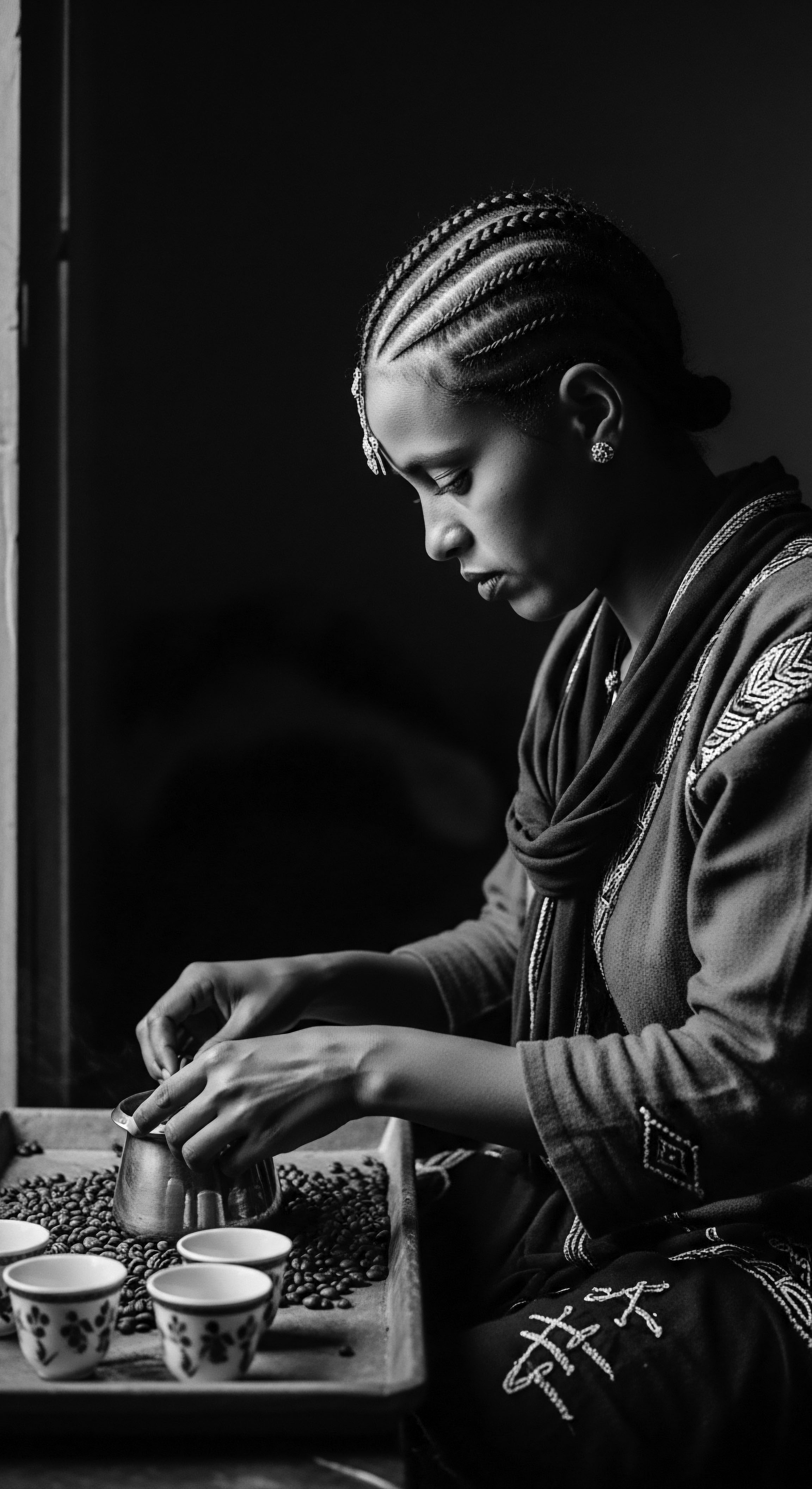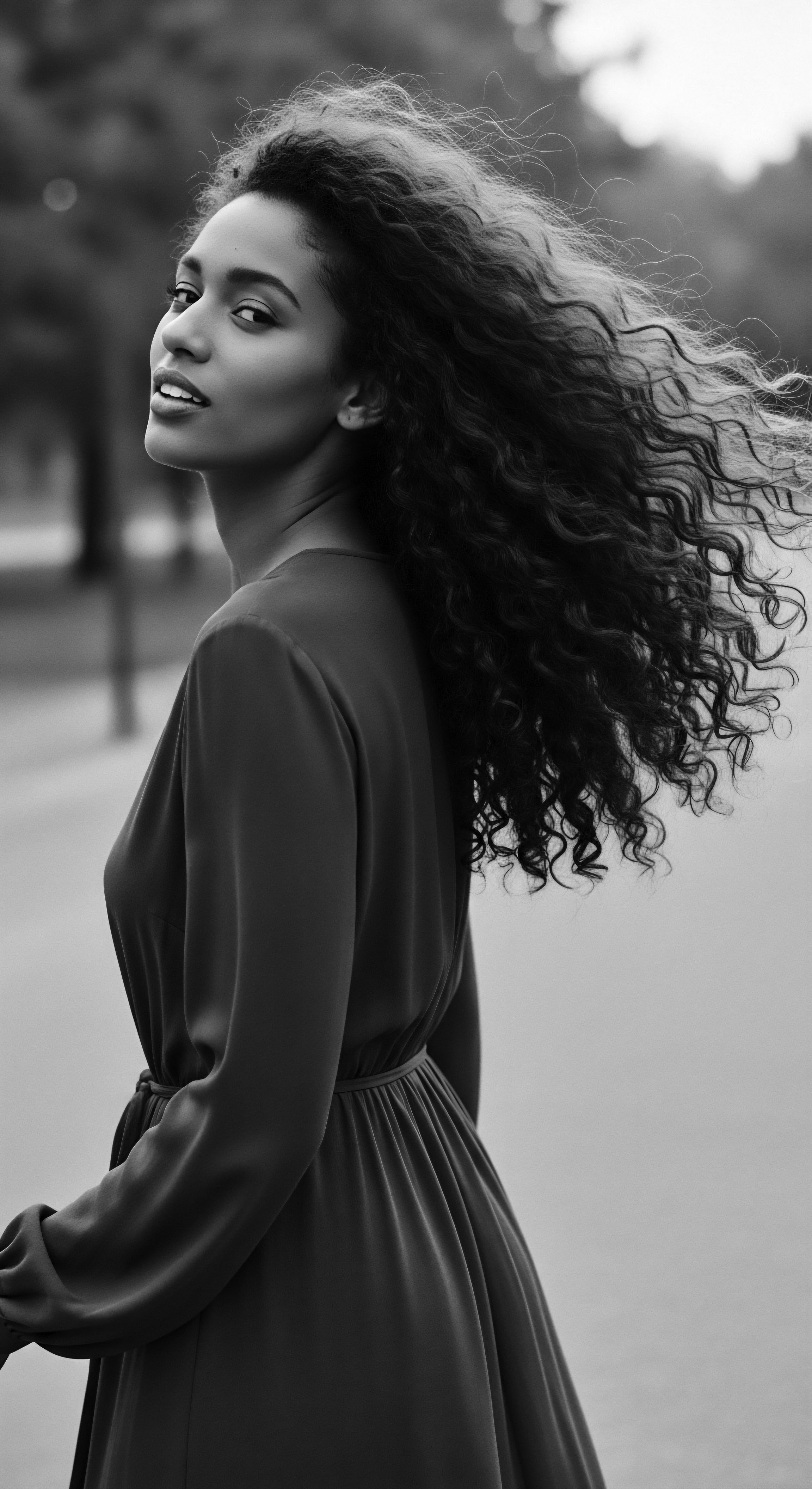
Fundamentals
The Natural Hair Movement Roots, at its fundamental core, represents a profound reacquaintance with the inherent character of textured hair. This isn’t merely a contemporary style preference; it marks a return to the foundational state of hair as it emerges from the scalp, free from chemical alteration or heat manipulation designed to forcibly straighten its distinct helical patterns. It is an acknowledgment that the rich diversity of coils, curls, and waves found predominantly within Black and mixed-race communities possesses an innate beauty and integrity, a truth often obscured by centuries of imposed aesthetic norms. The essence of this movement rests in recognizing that our hair, in its natural presentation, is not a problem to be solved but a heritage to be honored.
This journey back to the source begins with a contemplation of elemental biology. Textured hair, whether tightly coiled, loosely curled, or beautifully waved, possesses a unique follicular structure. The hair follicle itself, a tiny organ beneath the skin, dictates the shape of the hair strand. For textured hair, this follicle is typically oval or elliptical, rather than perfectly round.
This anatomical distinction influences the way keratin proteins assemble, creating disulfide bonds that lend themselves to the hair’s characteristic bends and curves. The orientation of these bonds, alongside varying distributions of protein, results in hair strands that spiral, zigzag, or undulate. Understanding this inherent biological disposition provides the initial step toward appreciating the Natural Hair Movement Roots ❉ it affirms that our hair’s diverse forms are not deviations from a standard, but rather part of a broad, healthy spectrum of human physiological expression.
Long before the advent of chemical straighteners or the pervasive influence of Western beauty ideals, ancestral practices across Africa revered and meticulously cared for textured hair. These ancient traditions understood hair as a vital extension of self, deeply interwoven with identity, status, spirituality, and community. From the intricate cornrows of the Fulani, used to denote marital status, to the elaborate, mud-laden dreadlocks of the Himba, signifying age and social standing, hair was a living canvas. It served as a visual language, transmitting stories of lineage, resilience, and belonging.
These practices, passed down through generations, were the earliest manifestations of understanding and working with natural hair, predating any contemporary ‘movement’ by millennia. They stand as testaments to an original relationship with hair, one characterized by respect and an innate wisdom of its needs.
The Natural Hair Movement Roots is fundamentally a reconnection with the intrinsic beauty and structural integrity of textured hair, reclaiming an identity long suppressed by external aesthetic pressures.
The understanding of hair’s meaning in these contexts was holistic. Hair care was not merely cosmetic; it was a ritual, a communal act, a moment of intergenerational teaching. Ingredients were sourced directly from the earth ❉ shea butter, derived from the karite tree, offering unparalleled moisture and protection; argan oil, precious liquid gold for conditioning; various clays for cleansing; and herbs for medicinal purposes and growth stimulation.
The hands that braided, twisted, and adorned were often those of elders, imbuing each strand with ancestral knowledge and communal connection. This deep heritage of care, rooted in the land and passed through touch, forms an indelible part of the Natural Hair Movement Roots, reminding us that true hair wellness often echoes the gentle wisdom of those who came before.
- Follicle Shape ❉ The elongated or flattened shape of hair follicles for textured hair types directly dictates the coiling or waving pattern of the strand as it grows.
- Keratin Alignment ❉ The asymmetrical distribution of keratin proteins within the hair shaft, influenced by follicle shape, contributes to the natural curl of textured hair.
- Disulfide Bonds ❉ The distinct arrangement of these chemical bonds within the hair shaft reinforces the unique helical structure of natural curls and coils.
| Concept Hair as Identity |
| Ancestral Practice/Understanding Braids, adornments, and styles denoting status, tribe, or life stage. |
| Modern Parallel/Validation Contemporary natural hair styles as expressions of self, culture, and resistance. |
| Concept Moisture Retention |
| Ancestral Practice/Understanding Use of natural butters (e.g. shea) and oils (e.g. coconut) to seal in hydration. |
| Modern Parallel/Validation Scientific understanding of textured hair's porosity and need for emollients; product formulations mirroring traditional ingredients. |
| Concept Protective Styling |
| Ancestral Practice/Understanding Braiding and twisting hair to prevent tangles and breakage. |
| Modern Parallel/Validation Modern recognition of low-manipulation styles and their role in length retention and hair health. |
| Concept These parallels underscore the timeless wisdom embedded within ancestral hair care practices, forming foundational elements of the Natural Hair Movement Roots. |

Intermediate
Moving beyond the elemental, the Natural Hair Movement Roots acquires layers of meaning through the living traditions of care and community—what we might call “The Tender Thread.” This section delves deeper into the historical lineage of textured hair, recognizing how its inherent structure and the ancestral practices surrounding it became profoundly intertwined with the social, political, and cultural narratives of Black and mixed-race people, particularly through the crucible of the transatlantic slave trade and its aftermath. The forced displacement and systemic dehumanization experienced by enslaved Africans represented a deliberate assault on every aspect of their identity, including their hair practices. Hair, once a sacred marker of belonging and status, was often shaved, shorn, or neglected in the horrific conditions of the Middle Passage and plantation life, serving as a cruel method of stripping individuality and cultural memory. Yet, even in this brutality, the resilience of the human spirit, and specifically the spirit of hair, found ways to persist.
The clandestine preservation of hair knowledge during slavery offers powerful testimony to the enduring significance of textured hair. Enslaved women, stripped of their tools and resources, found ingenious ways to maintain their hair, often using whatever natural elements were available—animal fats, rudimentary soaps, and wild herbs. Moreover, braiding and styling took on new, covert functions. Hair became a silent medium of communication, a repository of vital information.
This quiet act of preserving hair, in defiance of oppressive systems, established a profound, though often unspoken, root for future movements. It showcased how hair, despite being denied its public expression, remained a private testament to dignity and resistance.
The historical suppression of Black hair, though brutal, paradoxically strengthened its role as a silent symbol of resilience and an unyielding connection to heritage.
The period following emancipation saw a complex evolution of Black hair experiences. While freedom offered new possibilities, it also ushered in persistent pressures to assimilate into dominant Eurocentric beauty standards. The invention of the hot comb in the late 19th century and, later, chemical relaxers in the early 20th century, provided accessible means to achieve straight hair. For many, these tools offered a pathway to social mobility, perceived professionalism, and protection from discrimination in a society still deeply steeped in racial prejudice.
The choice to straighten hair, while seemingly personal, was often a response to systemic biases that linked natural Black hair to primitivism and unprofessionalism. This created a profound dichotomy ❉ the ancestral heritage of natural hair versus the pragmatic demands of survival and acceptance in a hostile world. Understanding this historical tension is vital to grasping the deep-seated origins of the Natural Hair Movement Roots.
The mid-20th century, particularly the Civil Rights Movement and the Black Power Movement, witnessed a powerful re-emergence of natural hair as a symbol of identity and protest. The Afro, in its unapologetic grandeur, became an icon of defiance against oppression and a visible declaration of Black pride. This styling choice was not merely a fashion statement; it was a socio-political stance, a rejection of imposed beauty ideals, and a reclamation of cultural heritage.
Figures like Angela Davis, with her commanding Afro, embodied this spirit, making the political personal through their hair. This era marked a pivotal public recognition of the Natural Hair Movement Roots, shifting it from a quiet act of defiance to a loud declaration of cultural self-acceptance.
- The Hot Comb’s Influence ❉ The accessibility of the hot comb allowed for temporary hair straightening, becoming a tool for perceived social advancement in a racially biased society.
- Chemical Relaxers ❉ The permanent alteration of hair texture through relaxers offered a sustained means of conforming to Eurocentric beauty standards, often driven by a quest for acceptance.
- The Afro as Protest ❉ The adoption of the Afro during the Black Power Movement served as a potent, visible symbol of racial pride and a rejection of oppressive aesthetic norms.
| Era Post-Emancipation (Late 19th Century) |
| Dominant Practice/Trend Emergence of hot comb, hair pressing for smoothness. |
| Underlying Social Context Desire for assimilation, perceived professionalism, and social acceptance in a discriminatory society. |
| Era Early 20th Century |
| Dominant Practice/Trend Widespread adoption of chemical relaxers. |
| Underlying Social Context Industrialization of beauty products, perpetuation of Eurocentric ideals, economic opportunities tied to appearance. |
| Era Mid-20th Century (1960s-1970s) |
| Dominant Practice/Trend The Afro, natural hair styles. |
| Underlying Social Context Civil Rights and Black Power Movements; a conscious rejection of assimilation, assertion of Black identity and heritage. |
| Era Each period reflects a complex interplay between ancestral hair knowledge, imposed societal pressures, and the evolving Black experience. |

Academic
The Natural Hair Movement Roots, from an academic vantage point, constitutes a multifaceted phenomenon, extending beyond a mere aesthetic trend to encompass a profound intergenerational legacy of morphological distinction, ancestral care modalities, and socio-political resistance embedded within the phenotypic expression of textured hair. This interpretative framework elucidates the deep-seated origins, both biological and cultural, that form the foundational substratum upon which contemporary affirmations of natural hair identity stand. It requires an examination of the intricate interplay between human biology, ethnobotanical traditions, colonial subjugation, and the enduring human imperative for self-determination. The ‘roots’ are thus not solely historical but extend into the very genetic makeup of populations, the ecological knowledge of ancestral lands, and the psychological impact of both oppression and liberation.
To comprehend the full scope of this academic definition, one must consider the profound historical continuity of hair as a site of both vulnerability and agency. The deliberate targeting of hair during the transatlantic slave trade exemplifies this paradox. African captives, whose hair was previously celebrated in complex styles that communicated tribal affiliation, marital status, and spiritual beliefs, faced the systematic destruction of these markers upon arrival in the Americas. Scalps were often shaved, tools were confiscated, and communal grooming rituals were violently suppressed, all designed to strip individuals of their cultural identity and sever their ties to ancestral knowledge.
This systematic erasure aimed to facilitate control and enforce a new, subordinate identity. However, even within this brutal reality, hair became a silent, resilient vessel for resistance.
Consider the remarkable, yet often understated, phenomenon of enslaved African women utilizing intricate braiding patterns to map escape routes or conceal rice seeds within their hair. This extraordinary practice, documented by historians and anthropologists studying the ingenuity of resistance, provides a potent case study of ancestral knowledge transforming into a tool for survival and cultural preservation (Byrd & Tharps, 2001). During the perilous journey and subsequent enslavement, women, particularly from rice-cultivating regions of West Africa like the Senegambian coast, braided rice and other seeds into their hair before forced migration. Upon arrival in the Americas, these hidden seeds, combined with ancestral agricultural knowledge, became the genesis of new food sources and contributed to cultural continuity in a foreign land.
Beyond mere sustenance, the hair itself became a dynamic, living cartography. Intricate cornrow patterns, often indistinguishable to the untrained European eye, served as tactile maps, depicting paths through swamps, forests, and plantations, guiding those seeking freedom. These complex braids, rich in symbolism and practical utility, represent a profound example of how hair, intrinsically tied to heritage and ancestral practice, was repurposed as a covert instrument of liberation and cultural memory. This historical reality underscores that the ‘roots’ of the Natural Hair Movement are not merely about aesthetics, but about life, liberty, and the clandestine preservation of an entire way of knowing and being.
The academic exploration of Natural Hair Movement Roots reveals it as a complex interplay of genetic heritage, suppressed cultural modalities, and persistent socio-political resistance embedded within textured hair.
The academic investigation also extends to the sociological and psychological impacts of hair texture in the diaspora. The sustained societal pressure to conform to Eurocentric beauty standards, particularly throughout the 19th and 20th centuries, led to widespread adoption of chemical relaxers. Research indicates the physiological consequences of such practices, including chemical burns, hair breakage, and long-term scalp damage (Khumalo et al. 2007).
Beyond the physical, the psychological toll was considerable, contributing to self-esteem issues and internalized perceptions of beauty that marginalized natural hair. The Natural Hair Movement, then, is a response to this historical trauma, an effort to heal and reclaim a lost connection. It represents a collective renegotiation of beauty standards, asserting the inherent validity and attractiveness of diverse textured hair types. This reclamation is not simply about personal preference; it carries significant implications for racial identity formation, collective self-worth, and cultural pride within Black and mixed-race communities globally.

Phylogenetic and Morphological Underpinnings
The biological architecture of textured hair demands academic attention. Recent genetic studies have identified specific gene variants, such as EDAR and FGFR2, that influence hair shaft morphology and curl pattern, particularly prevalent in populations of African descent. These genetic predispositions lead to the formation of elliptical or ribbon-shaped hair follicles, which, in turn, produce strands with an inherent helical structure. The uneven distribution of keratin proteins within the cortical cells, alongside the arrangement of disulfide bonds, causes the hair strand to curl as it grows.
Understanding these phylogenetic roots provides a scientific bedrock for the Natural Hair Movement, confirming that the diversity of textured hair is not a random occurrence but a deeply encoded biological inheritance. This scientific understanding dismantles pseudo-scientific hierarchies that historically positioned straight hair as superior, validating the inherent naturalness and complexity of coils and curls.

Ethnobotanical Traditions and Sustained Care
A critical aspect of the Natural Hair Movement Roots, from an academic perspective, is the revival and scholarly examination of ethnobotanical hair care practices. Pre-colonial African societies possessed sophisticated knowledge of local flora for cosmetic, medicinal, and spiritual purposes related to hair. Ingredients such as Shea Butter (Vitellaria paradoxa), Baobab Oil (Adansonia digitata), and various clays were not merely topical applications; they were integrated into rituals that emphasized communal bonding and ancestral veneration. These traditions provided moisture, protection, and gentle cleansing, aligning perfectly with the inherent needs of textured hair, which tends to be more prone to dryness due to its coiled structure limiting the natural sebum flow from the scalp down the hair shaft (Okereke et al.
2011). The contemporary Natural Hair Movement re-engages with this ancestral knowledge, researching and reintroducing these ingredients, thereby creating a bridge between ancient wisdom and modern wellness. This academic lens allows for the critical evaluation of traditional practices, identifying their scientific efficacy and cultural significance.
- Shear Butter (Vitellaria Paradoxa) ❉ Revered for its emollient properties, it was used to seal moisture into hair strands, a practice affirmed by modern science for low-porosity textured hair.
- Chebe Powder ❉ A Chadian blend of herbs, historically used to strengthen hair and promote length retention through moisture and protein retention; a technique now explored for its efficacy.
- Black Soap (Alata Samina) ❉ Originating from West Africa, this gentle cleanser, often made from plantain skins and cocoa pods, provided effective cleansing without stripping natural oils, proving ideal for textured hair’s delicate nature.

Socio-Cultural Semiotics and Identity Formation
The Natural Hair Movement Roots also presents itself as a significant field of study in socio-cultural semiotics—the analysis of signs and symbols within a culture. Hair, as a highly visible and modifiable aspect of the human body, serves as a powerful non-verbal communicator of identity, belonging, and political stance. The choice to wear one’s hair naturally in contexts historically hostile to such expression becomes a declarative act. It is a symbol of self-acceptance, a rejection of internalized racism, and an affirmation of racial identity.
This semiotic shift impacts psychological well-being, fostering a greater sense of authenticity and pride among individuals and within communities. The academic focus here lies in dissecting how hair choices contribute to identity negotiation, challenge systemic biases, and promote cultural revitalization within the African diaspora. This deeper understanding reveals how hair, in its natural state, becomes a vehicle for expressing solidarity, cultural memory, and an enduring connection to ancestral roots.
| Dimension Hair Morphology |
| Historical/Ancestral Context Observed diversity of coils and curls across African ethnic groups, leading to varied styling techniques. |
| Scientific/Academic Validation Genetic studies identifying specific gene variants (e.g. EDAR) responsible for follicle shape and curl patterns (e.g. Fujimoto et al. 2008). |
| Dimension Protective Styling |
| Historical/Ancestral Context Braiding and wrapping hair to preserve length and protect against environmental damage, especially for agricultural societies. |
| Scientific/Academic Validation Microscopic analysis confirming reduced friction, minimized manipulation, and decreased breakage rates in protective styles. |
| Dimension Natural Ingredients |
| Historical/Ancestral Context Consistent use of plant-based oils, butters, and herbs for cleansing, conditioning, and scalp health across diverse African traditions. |
| Scientific/Academic Validation Biochemical analysis revealing emollient, anti-inflammatory, and antimicrobial properties of traditional ingredients like shea butter and baobab oil (e.g. Maranz & Wiesman, 2003). |
| Dimension The convergence of ancient wisdom and modern scientific inquiry offers a holistic understanding of textured hair's inherent needs and capabilities, affirming the profound basis of the Natural Hair Movement Roots. |
The long-term consequences of engaging with the Natural Hair Movement Roots are far-reaching. Beyond individual empowerment, it fosters a collective re-evaluation of beauty standards across society. This leads to increased representation in media, a growth in culturally appropriate product development, and a broader appreciation for the diverse spectrum of human beauty.
From an academic perspective, it provides fertile ground for interdisciplinary research combining anthropology, genetics, sociology, and public health, all centered on understanding the deep cultural and biological significance of hair. The success of the movement is measured not only in personal journeys of self-acceptance but in its capacity to reshape societal perceptions and dismantle ingrained prejudices, cementing hair as a potent force for cultural and individual liberation.

Reflection on the Heritage of Natural Hair Movement Roots
To truly feel the resonance of the Natural Hair Movement Roots is to understand that it is not a finished chapter but a living, breathing testament to the enduring spirit of textured hair and the communities it adorns. It is a continuous dialogue between the ancient whispers of ancestral practices and the contemporary affirmations of identity. Each coil and curl, each wave and kink, carries within it a profound memory—a memory of survival, ingenuity, and unyielding beauty in the face of historical adversity. The very act of caring for natural hair today, whether through meticulous oiling or patient detangling, echoes rituals performed by hands long past, hands that kneaded shea butter into strands under an African sun, or carefully braided messages of hope in the shadows of enslavement.
This journey back to our hair’s inherent state is a quiet revolution, a return to what has always been ours. It speaks to a deep, cellular recognition of belonging, a reconnection with a heritage that was systematically dismembered but never truly destroyed. The wisdom of our ancestors, regarding hair not merely as appendage but as a conduit of spirit and a marker of lineage, guides our present-day understanding. It reminds us that our hair is a crown, not only of personal expression but of inherited legacy.
The texture of our hair, once deemed a disadvantage, stands now as a vibrant testament to genetic diversity and cultural richness. The Natural Hair Movement Roots continues to deepen this appreciation, inviting individuals to look beyond superficial appearances and recognize the profound stories held within each strand. It is a call to honor the tender thread that connects us to our past, allowing us to stride into the future with a confidence rooted in ancestral wisdom and an unwavering celebration of self.

References
- Byrd, Ayana, and Lori Tharps. Hair Story ❉ Untangling the Roots of Black Hair in America. St. Martin’s Press, 2001.
- Fujimoto, Akihiro, et al. “A Single Nucleotide Polymorphism in EDAR Is Associated with Asian Hair Thickness.” American Journal of Human Genetics, vol. 83, no. 5, 2008, pp. 544–555.
- Khumalo, Nonhlanhla P. et al. “Prevalence and Incidence of Hair Breakage in an African Population ❉ A Study of Women in South Africa.” Journal of the American Academy of Dermatology, vol. 57, no. 3, 2007, pp. 432–439.
- Maranz, Steven, and Zev Wiesman. Shea Butter ❉ A Global Commodity. CRC Press, 2003.
- Okereke, Anthony, et al. “Hair Characteristics of Women of African Descent ❉ A Preliminary Study.” Journal of Cosmetic Dermatology, vol. 10, no. 4, 2011, pp. 310–314.
- Taylor, Tiffani Dawn. African American Hair ❉ An Encyclopedia of Hair Culture. ABC-CLIO, 2021.
